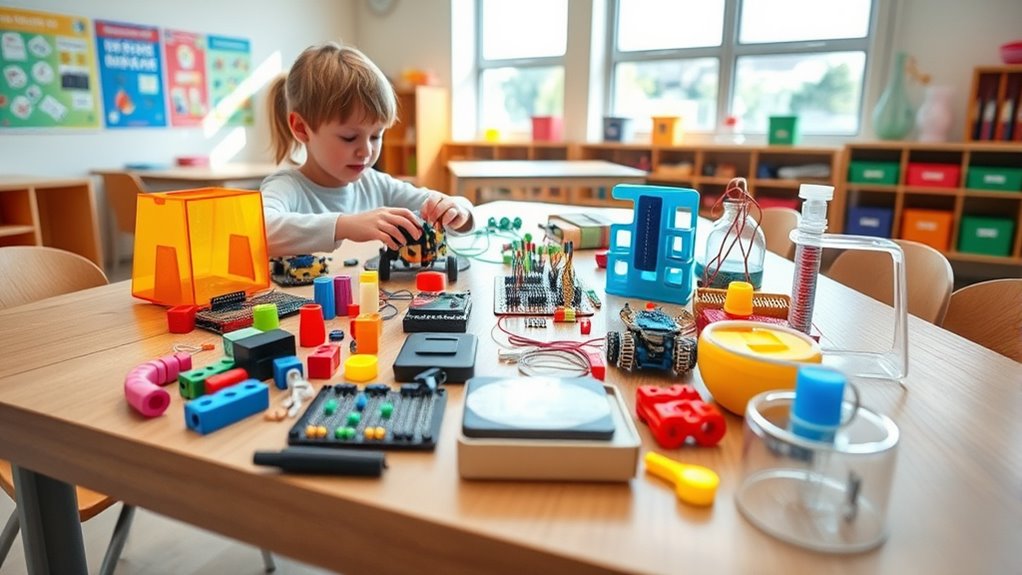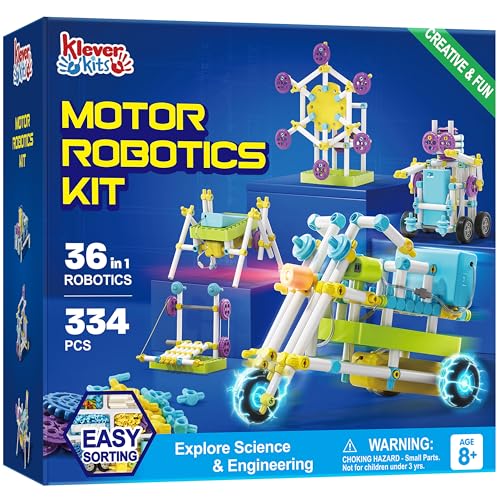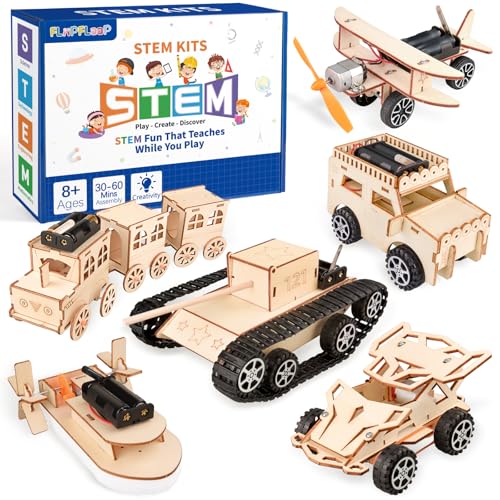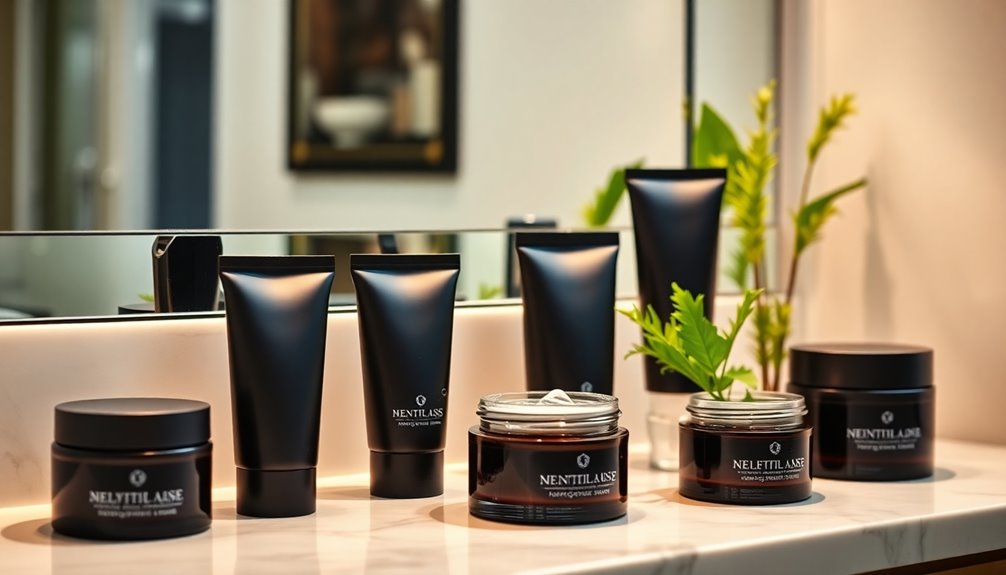If you’re looking for the best educational STEM kits that make learning fun and engaging, I’ve found some great options. From easy-to-use snap circuits and robotic builds to earth sciences and plant ecosystems, these kits promote critical thinking, creativity, and hands-on exploration. They cater to various ages and interests while fostering curiosity and problem-solving. Keep exploring, and you’ll discover even more exciting options that inspire young learners to grow their STEM skills.
Key Takeaways
- The best STEM kits combine hands-on activities with educational content to foster creativity, problem-solving, and critical thinking skills.
- Kits like Snap Circuits Jr. and Klever Kits are award-winning, beginner-friendly options promoting electrical engineering and robotics learning.
- Renewable energy and environmental science are emphasized in kits such as the Sillbird Solar Robot and Grow N Glow Terrarium.
- Many kits include detailed instructions, tutorials, and multi-model projects to keep kids engaged and encourage independent exploration.
- Durability, safety, and age-appropriate complexity are key factors in selecting engaging STEM kits for kids.
Snap Circuits Jr. SC-100 Electronics Exploration Kit
Are you searching for a beginner-friendly electronics kit that safely introduces kids to STEM concepts? The Snap Circuits Jr. SC-100 is perfect for children aged 8 and up. It offers a hands-on way to learn about electrical engineering by building over 100 projects, from flying saucers to alarms. The kit includes 28 color-coded, snap-together parts that make assembly easy—no soldering or tools needed. With a detailed instruction manual, kids can confidently explore circuits and problem-solving. It’s a fun, educational gift that promotes creativity and STEM skills, recognized with awards like the Best Toys and STEM.org Trustmark.
Best For: children aged 8 and up who want a safe, educational, and hands-on introduction to electronics and STEM concepts.
Pros:
- Easy to assemble with snap-together parts, no soldering or tools required
- Offers over 100 engaging projects to foster creativity and problem-solving
- Recognized with multiple awards and endorsed by educational and toy organizations
Cons:
- Requires batteries for operation, which are not included
- May be too simple for older or more advanced electronics enthusiasts
- Limited to a single set unless expanded with additional compatible kits
Sillbird 12-in-1 Solar Robot Building Kit for Kids
The Sillbird 12-in-1 Solar Robot Building Kit is an excellent choice for kids aged 8 to 13 who are enthusiastic to explore engineering and renewable energy through hands-on play. It includes 190 pieces to build 12 models like robots and cars, with increasing difficulty to match their skills. The large solar panel captures sunlight for outdoor use or artificial light indoors, providing a fun way to learn about solar power. Clear instructions support independent or family assembly, fostering problem-solving and creativity. While assembly can be tricky, this kit offers engaging STEM experiences that promote critical thinking and a basic understanding of renewable energy concepts.
Best For: children aged 8 to 13 who are interested in hands-on STEM activities, engineering, and renewable energy concepts.
Pros:
- Offers 12 different models to build, encouraging creativity and problem-solving skills.
- Includes a large solar panel that promotes learning about solar energy and environmental sustainability.
- Comes with clear, step-by-step instructions suitable for independent or family assembly.
Cons:
- Assembly can be challenging due to small, sharp plastic pieces and sometimes confusing instructions.
- Effectiveness of solar-powered movement depends heavily on sunlight, limiting indoor use or cloudy days.
- Some users report parts breaking or not fitting well, affecting durability and overall functionality.
Klever Kits 36-in-1 Motor Robotic Kits for Kids
If you’re looking for a versatile STEM kit that sparks creativity and hands-on learning, Klever Kits 36-in-1 Motor Robotic Kits is an excellent choice. It lets kids build 36 different robots, including walking machines and racing cars, promoting exploration and problem-solving. The kit is well-organized with easy-to-follow instructions and video tutorials, making assembly straightforward for children aged 8 and up. Constructing various robots helps develop engineering skills, critical thinking, and teamwork. Plus, the durable, safe materials assure a reliable, fun experience. Overall, this kit offers an engaging way to introduce kids to core STEM concepts while fostering independence and persistence.
Best For: kids aged 8 and above who are interested in STEM, robotics, and hands-on creative building experiences.
Pros:
- Offers 36 different robots to build, including motorized models like walking machines and racing cars
- Comes with clear instructions and video tutorials for easy assembly
- Promotes development of problem-solving, engineering skills, and teamwork through engaging play
Cons:
- Some users report difficulty matching parts to instructions due to color discrepancies
- Battery pack assembly and motor orientation can be challenging for younger children
- A few components, like the light, may arrive broken or defective
Poraxy 4 in 1 STEM Kits for Kids Age 8-10
Poraxy’s 4-in-1 STEM Kits are an excellent choice for kids aged 8 to 10 who love hands-on learning and creative projects. These kits include fun science models like mini ferris wheels, carousels, fiber optic lamps, and star night lights, making them perfect for birthdays or Christmas. Designed for children 6-14, they promote problem-solving, creativity, and engineering skills. The high-quality wooden parts are easy to assemble, and kids can personalize their projects with paint and decorations. With lights that change colors, these models add a magical touch to any room. Overall, they offer engaging educational fun that nurtures curiosity and critical thinking.
Best For: children aged 8 to 10 who enjoy hands-on STEM activities, creative projects, and educational fun that fosters problem-solving and engineering skills.
Pros:
- High-quality, laser-cut wooden components that are easy to assemble and safe for children
- Encourages creativity through painting and decorating, personalizing each project
- Features engaging lights and moving parts that add a magical, decorative touch to any room
Cons:
- Assembly may require adult supervision, especially for younger children or those new to DIY projects
- Some users find the materials to be inexpensive or lightweight, which may affect durability
- Instructions can sometimes be unclear or require adult assistance to complete complex steps
National Geographic STEM Science Kit (Amazon Exclusive)
Designed for curious young scientists, the National Geographic STEM Science Kit (Amazon Exclusive) offers over 15 engaging activities that bring earth sciences to life. Kids can experiment with dueling water tornadoes, erupting volcanoes, crystal growing, and geologic digs, providing hands-on learning experiences. The kit includes a detailed, full-color guide that explains scientific concepts, helping children develop a deep understanding of Earth sciences. It’s perfect for sharing with family or friends, encouraging collaborative discovery. The user-friendly instructions boost confidence and make experimentation easy and fun. Made with high-quality materials, this kit guarantees a positive, educational experience backed by excellent customer support.
Best For: curious young scientists and families seeking engaging, hands-on earth science activities that foster learning and collaboration.
Pros:
- Offers over 15 diverse and engaging experiments to stimulate curiosity and learning.
- Includes a comprehensive, full-color guide that explains scientific concepts clearly.
- Designed with easy-to-follow instructions, boosting children’s confidence and independent exploration.
Cons:
- Some activities may require additional household items not included in the kit.
- The variety of experiments might be overwhelming for very young children without supervision.
- As an Amazon Exclusive, availability may be limited or subject to stock fluctuations.
Creativity for Kids Grow N Glow Terrarium Kit
The Creativity for Kids Grow N’ Glow Terrarium Kit stands out as an ideal choice for children aged 6 to 8 who love hands-on science projects and imaginative play. I love how it lets kids create their own mini ecosystems inside a mason jar, blending science with creativity. The kit includes everything needed for planting, decorating, and caring for the plants, with glow-in-the-dark accents that make the terrarium magical at night. It encourages responsibility, curiosity about nature, and environmental awareness, all while promoting fine motor skills and patience. Plus, the reusable jar means kids can enjoy multiple planting cycles, making it a fun, educational gift that sparks discovery.
Best For: children aged 6-8+ who enjoy hands-on science, creative crafting, and learning about nature through engaging, screen-free activities.
Pros:
- Encourages hands-on learning and responsibility through plant care and eco-awareness
- Includes glow-in-the-dark accents for a magical nighttime display
- Reusable jar allows for multiple planting cycles, extending the educational fun
Cons:
- Growth process takes a few days, so immediate results are not visible
- Some users may find assembly or decorating instructions require supervision for younger children
- Limited to small-scale ecosystems, which may not satisfy children seeking larger or more complex projects
60+ Science Experiment Kit for Kids Ages 5-8, STEM Educational Science Gifts
If you’re looking for an engaging way to introduce young children to science, this Science Experiment Kit for Kids Ages 5-8 is an excellent choice. It includes over 60 hands-on experiments like volcanic eruptions, dinosaur egg digging, and lava lamps, making learning fun and interactive. The kit promotes curiosity, critical thinking, and problem-solving as kids observe chemical reactions and explore scientific concepts. All materials, tools, and safety gear are included, with easy-to-follow instructions for independent or guided play. Designed specifically for ages 5-8, it’s perfect for birthdays, holidays, or weekend activities, inspiring a love for science early on.
Best For: young children aged 5-8 who are curious about science and enjoy hands-on, educational activities.
Pros:
- Encourages STEM learning through engaging, age-appropriate experiments
- Includes all necessary materials and safety gear for safe, independent play
- Promotes critical thinking, problem-solving, and scientific curiosity in a fun way
Cons:
- May require adult supervision for some experiments to ensure safety
- The variety of experiments might be overwhelming for some young children
- The kit’s small parts could pose a choking hazard if not used carefully
Dan&Darci Light-Up Terrarium Kit for Kids
For kids aged 6 to 12 who love nature and hands-on science projects, the Dan&Darci Light-Up Terrarium Kit offers an engaging way to explore gardening and ecosystems. This kit lets children create a miniature garden inside a jar, complete with layers of rocks, soil, and seeds. The highlight is the LED-lit lid that transforms the terrarium into a glowing, enchanting display at night. It’s rechargeable and easy to use, making the experience even more captivating. With detailed instructions and fun decorative stickers, kids can customize their miniature world while learning about plant growth, ecosystems, and basic science concepts—all in a creative, interactive package.
Best For: kids aged 6-12 who are interested in nature, gardening, science, and creative crafts.
Pros:
- Engages children in hands-on STEM learning through planting and decorating.
- Features an LED-lit lid that creates a beautiful glow at night, enhancing visual appeal.
- Includes comprehensive materials and clear instructions for an easy and enjoyable DIY experience.
Cons:
- Requires charging via Micro-USB, which may be inconvenient if the cable is misplaced.
- The miniature garden may need ongoing maintenance and care from children or parents.
- Limited to a small terrarium size, which might not satisfy children wanting larger projects.
Learning Resources STEM Explorers Pixel Art Challenge
Designed specifically for children aged 5 and up, Learning Resources STEM Explorers Pixel Art Challenge offers a fun, screen-free way to build STEM skills through creative pixel art. I love how it combines art with science, technology, engineering, and math, turning craft time into a learning opportunity. With 402 foam pieces, challenge cards, and a 10×10 base, kids can create colorful pixel designs inspired by classic video games. The set supports problem-solving, spatial reasoning, and fine motor skills while encouraging perseverance. Its variety of challenges keeps children engaged, making it a versatile tool for classrooms, homeschooling, or independent play.
Best For: children aged 5 and up who enjoy creative, hands-on STEM activities that combine art and problem-solving.
Pros:
- Promotes STEM learning through engaging, screen-free pixel art challenges
- Enhances fine motor skills, spatial reasoning, and problem-solving abilities
- Bright, colorful design and varied difficulty levels keep children motivated and entertained
Cons:
- Some users report foam pieces can be inconsistent in size or dislodge easily
- Limited challenge options may not suit older children seeking more complexity
- Foam quality and durability issues have been noted in some reviews
Doctor Jupiter Science Kit for Kids Ages 4-8
The Doctor Jupiter Science Kit for Kids Ages 4-8 stands out as an excellent choice for young children enthusiastic to explore science through hands-on activities. With over 100 experiments, it sparks curiosity with projects like underwater volcanoes, water fireworks, and color-changing activities, covering chemistry and physics. Designed for safety and ease of use, it includes clear instructions and kid-friendly tools. This kit encourages critical thinking, observation, and problem-solving, making learning fun and engaging. Highly rated with 4.6 stars, it’s perfect as a gift or educational tool to inspire a love for science in young learners.
Best For: young children aged 4-8 who are curious about science and enjoy hands-on, educational activities.
Pros:
- Offers over 100 engaging experiments that cover various science topics such as chemistry and physics.
- Designed with safety and ease of use in mind, including kid-friendly tools and clear instructions.
- Highly rated (4.6 stars) with positive feedback on inspiring curiosity and making learning fun.
Cons:
- Some users mention minor difficulties in removing large bottles from packaging.
- The kit may require adult supervision for younger children or those just starting out.
- Limited to a specific age range (4-8), which might not extend to older children interested in more advanced experiments.
UNGLINGA 70 Lab Experiments Science Kits for Kids
If you’re looking for an all-encompassing science kit that sparks curiosity in young aspiring scientists, UNGLINGA 70 Lab Experiments Science Kits for Kids is an excellent choice. It offers a wide range of engaging experiments, from erupting volcanoes to crystal growing and balloon rockets, providing hours of educational fun for kids aged 8 and up. The kit includes safe, child-friendly ingredients and clear manuals that guide kids step-by-step through each activity. It promotes hands-on learning, critical thinking, and teamwork, making science accessible and exciting. Parents and educators love its durability, ease of use, and the opportunity it gives children to explore science like real scientists.
Best For: children aged 8 and above, parents, and educators seeking a comprehensive, engaging, and safe science learning experience.
Pros:
- Offers a wide variety of 70 experiments to keep kids engaged and curious
- Includes clear, illustrated manuals for easy, step-by-step guidance
- Promotes hands-on learning, critical thinking, and teamwork skills
Cons:
- Additional household items like lemons or flour may be needed for some experiments
- Some instructions can be vague or confusing for younger children
- Beakers and certain tools require hand-washing and careful handling to ensure longevity
UNGLEA 50+ Science Lab Experiments Kit for Kids
The UNGLEA 50+ Science Lab Experiments Kit is perfect for curious kids who love hands-on learning and exploring the world of science. It offers over 50 experiments covering Earth sciences, chemistry, and magic, using household items like baking soda, vinegar, and colorful solutions. Kids can build volcanoes, create gemstones, change flower colors, and produce rainbow rain, making science exciting and accessible. The kit encourages critical thinking, problem-solving, and STEM skills through real laboratory activities. A detailed manual explains the science behind each experiment, helping children grasp fundamental principles while having fun. This durable, safe kit truly inspires a lasting interest in science and discovery.
Best For: curious kids and families seeking an engaging, educational STEM activity kit to foster hands-on learning and scientific curiosity at home.
Pros:
- Includes over 50 diverse experiments covering earth sciences, chemistry, and magic, providing extensive exploration options.
- Comes with a detailed, easy-to-follow manual that explains scientific concepts, enhancing understanding and learning.
- Made from durable, safe materials, ensuring hours of exploration and suitability for sharing with friends and family.
Cons:
- Requires household items like baking soda and vinegar, which may need to be purchased separately if not already available.
- Some experiments might be challenging for very young children without adult supervision.
- The kit’s extensive content may be overwhelming for very young or beginner science enthusiasts.
6-in-1 STEM Kits for Kids Aged 8-12
Designed specifically for children aged 8 to 12, 6-in-1 STEM kits offer a versatile and engaging way to explore science and engineering concepts. I find these kits perfect for hands-on learning, with six different models like hydraulic excavators, Newton’s cradle, and space projects. Made from durable, eco-friendly wooden components, they promote safety and longevity. The easy-to-follow instructions make assembly accessible, encouraging creativity, problem-solving, and teamwork. Plus, they’re excellent for parent-child bonding. These kits are ideal gifts for birthdays or holidays, providing hours of educational fun while reducing screen time and fostering curiosity about the physical world.
Best For: children aged 8-12 who are interested in hands-on STEM learning, engineering, and science projects that promote creativity, problem-solving, and parental bonding.
Pros:
- Engaging and educational with six diverse models to explore physics and engineering principles
- Made from durable, eco-friendly wooden components ensuring safety and longevity
- Easy-to-follow instructions make assembly accessible, fostering creativity and teamwork
Cons:
- Some users may find the instructions could be clearer for easier assembly
- Requires AA batteries (not included), adding to the overall cost
- Limited to models included; may need additional projects for extended interest
Sntieecr Electric Circuit Motor Kit for Kids
Looking for a hands-on STEM kit that sparks curiosity in children aged 8 and up? The Sntieecr Electric Circuit Motor Kit is perfect for young learners excited to explore electronics and engineering. It includes essential components like motors, switches, bulbs, propellers, and detailed instructions, making assembly straightforward. Kids can experiment with simple circuits, learn about electrical principles, and even create moving projects. Designed for safety and educational value, it encourages critical thinking, problem-solving, and creativity. Whether for classroom activities or home experiments, this kit offers a fun, engaging way to plunge into the world of electricity and motors.
Best For: young learners aged 8 and above interested in exploring electronics, engineering, and STEM activities through hands-on experiments.
Pros:
- Comprehensive set of components including motors, switches, bulbs, and propellers for versatile projects
- Encourages critical thinking, creativity, and problem-solving skills in children
- Compact and affordable, making it suitable for classroom use and home learning
Cons:
- Some users report defective bulbs or small instruction pamphlets that can hinder the learning process
- Components like motors may be weak or unsuitable for complex projects such as drones
- Safety concerns with overheating or melting wires if used improperly or at higher voltages
STEM Electric Circuit Kit for Kids Ages 8-12
If you’re searching for a hands-on way to introduce kids aged 8-12 to electrical engineering, the STEM Electric Circuit Kit is an excellent choice. It features eight engaging experiments, including series and parallel circuits, fruit batteries, and saltwater power generation. The kit includes pre-cut insulated wires, a detailed circuit book, and all necessary parts for kids to build and learn. Designed to foster critical thinking, problem-solving, and creativity, it’s perfect for home, classroom, or science fair projects. While small parts require supervision, kids often complete experiments independently, making it a valuable and fun educational resource to spark their interest in electricity.
Best For: parents, teachers, and STEM enthusiasts seeking an engaging, educational, and hands-on electrical engineering kit for children aged 8-12 to foster critical thinking and creativity.
Pros:
- Includes a variety of experiments such as series/parallel circuits, fruit batteries, and saltwater power generation, promoting diverse learning experiences
- Comes with pre-cut insulated wires, a detailed instruction book, and all necessary components for easy setup and use
- Encourages independent learning while being suitable for classroom projects, science fairs, and home experiments
Cons:
- Small parts and wires may require adult supervision, especially for younger children
- Fine wiring manipulation can sometimes affect connection reliability, needing careful handling
- Batteries are required but not included, which may add to the overall cost
Factors to Consider When Choosing Educational STEM Kits for Kids
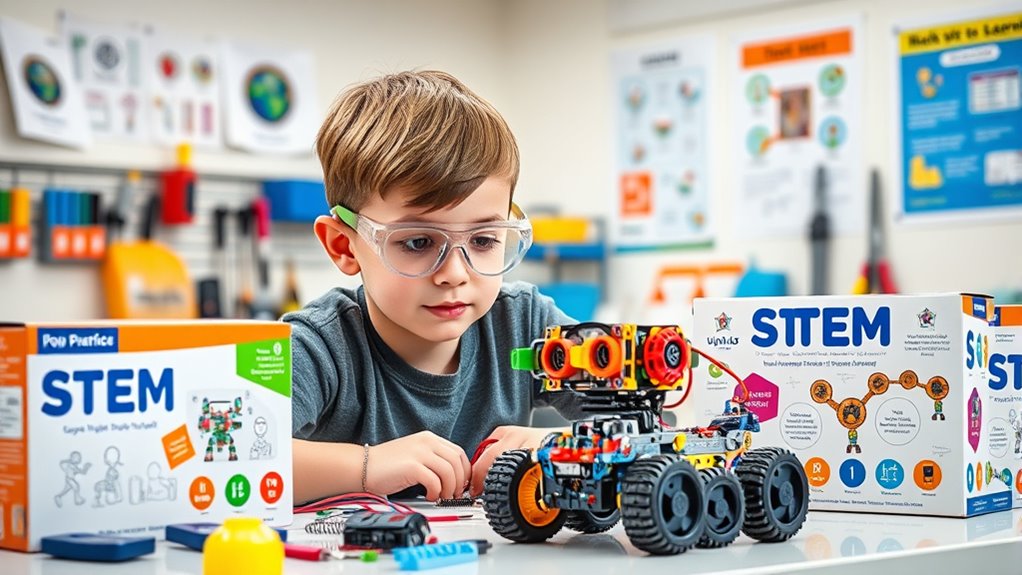
When choosing STEM kits for kids, I always consider if the content matches their age and skill level to keep them engaged and challenged. Safety features and durable materials are also top priorities to guarantee a worry-free experience. Finally, I look at the build complexity to find a kit that balances educational value with appropriate difficulty.
Age Appropriateness
Choosing the right STEM kit for a child depends heavily on age-appropriate design and complexity. It’s essential to check the packaging for the recommended age range to guarantee the kit matches the child’s developmental level. For kids under 8, look for kits with large, safe components that are easy to handle, reducing choking risks and making assembly straightforward. For ages 8-12, select kits with more challenging projects that encourage critical thinking and problem-solving. Also, consider the child’s reading ability; clear, simple instructions are key to maintaining engagement and fostering independence. An age-appropriate kit strikes a balance—challenging enough to inspire confidence without causing frustration, making learning both fun and accessible.
Educational Content
Selecting an educational STEM kit requires careful attention to the content it offers. I look for kits with clear, detailed instructions and explanations that help kids grasp the scientific principles behind each activity. The content should cover various topics like physics, chemistry, biology, or engineering to build a well-rounded understanding of STEM concepts. I also prioritize kits that include experiments promoting critical thinking, problem-solving, and analytical skills through hands-on projects. It’s important that activities align with the child’s age and developmental level, ensuring they’re challenging yet achievable. Well-designed kits also connect activities to real-world applications, inspiring curiosity and demonstrating how STEM skills are used daily. This exhaustive approach keeps learning engaging, meaningful, and fun for kids.
Safety Features
Ensuring safety is a critical factor when picking out educational STEM kits for kids, as these kits often involve small parts and potentially hazardous materials. I always check that the kit complies with safety standards like ASTM F963-17 or CE certification, confirming it has passed safety tests. I look for non-toxic, BPA-free, child-safe materials to prevent health risks during play. Features like rounded edges, secure closures, and sturdy construction help minimize cuts, pinching, or choking hazards. It’s also essential to verify that small parts are clearly labeled with choking hazard warnings and are suitable for the child’s age. Ultimately, I review the manufacturer’s instructions to guarantee proper supervision, safety precautions, and age recommendations are provided, guaranteeing safe and enjoyable learning experiences.
Build Complexity
Since the build complexity of a STEM kit directly impacts a child’s learning experience, it’s important to match the kit’s difficulty level with their age and skills. A kit that’s too simple may bore older children, while one that’s too challenging can cause frustration. Look for kits with multiple difficulty levels or expandable components, so they can grow with your child’s abilities and keep them engaged long-term. Consider the number and complexity of projects included—more intricate projects can better suit advanced learners. Keep in mind that highly complex kits with many small parts or advanced concepts might require adult supervision or some prior knowledge for safe assembly. Choosing the right build complexity ensures your child stays challenged, motivated, and enthusiastic to learn.
Material Durability
When choosing an educational STEM kit, considering the material durability is just as important as evaluating the build complexity. Durable materials like high-quality plastics, wood, and metal ensure the kit withstands frequent use and rough handling. Non-toxic, child-safe components reduce the risk of breakage from saliva, moisture, or accidental drops. Thick, reinforced plastic parts and sturdy joints prevent cracking or loosening during assembly and play. Well-made components resistant to warping and corrosion help maintain functionality and safety over time. Investing in durable materials not only prolongs the lifespan of the kit but also provides better value, as it reduces the need for replacements. Ultimately, strong, high-quality materials keep kids engaged and safe, making the learning experience more enjoyable and sustainable.
Price and Value
Choosing the right STEM kit involves balancing cost and educational value, as prices can vary markedly—from under $20 to over $100. While higher-priced kits often include more components, diverse projects, and better durability, they may not always be necessary for quality learning. Budget-friendly options can still offer valuable experiences, but might have fewer projects or require extra purchases for expansion. To assess if a kit is worth its price, I compare the number of experiments and their complexity, ensuring it matches the educational benefit. Customer reviews and ratings are also helpful, revealing whether the features justify the cost and if kids stay engaged. Ultimately, finding the right balance means selecting a kit that provides meaningful learning without overspending.
Frequently Asked Questions
How Do STEM Kits Enhance Long-Term Interest in Science and Technology?
STEM kits boost my long-term interest in science and tech by making learning hands-on and exciting. When I build and experiment, I see real-world applications and develop curiosity. These kits challenge me to think critically and problem-solve, which keeps me motivated to explore more. I find that engaging activities foster a genuine passion, helping me stay curious and enthusiastic to learn about new discoveries and innovations in the future.
Are STEM Kits Suitable for Children With No Prior STEM Experience?
Absolutely, STEM kits are perfect for children with no prior experience. They’re designed to be simple, engaging, and educational, making learning accessible and fun. These kits introduce kids to fundamental concepts through hands-on activities, fostering curiosity, confidence, and a love for discovery. Whether a beginner or not, children can explore, experiment, and learn at their own pace, building a strong foundation for future STEM interests.
How Safe Are Electrical and Chemical Experiments in These Kits?
Electrical and chemical experiments in these kits are generally safe when kids follow the provided instructions and adult supervision is present. Manufacturers design these kits with safety in mind, including child-safe materials and clear guidelines. I always recommend parents or guardians supervise to prevent accidental misuse. When used properly, these kits offer a safe, engaging way for children to explore science and develop a love for learning.
Can These Kits Be Used Effectively in Classroom Settings?
Yes, these STEM kits can be very effective in classroom settings. I’ve seen how they stimulate curiosity and hands-on learning, making complex concepts accessible and fun. When integrated properly, they encourage teamwork and problem-solving skills among students. Just guarantee safety guidelines are followed, and have enough materials for everyone. They’re a fantastic way to bring science, technology, engineering, and math to life in an engaging, practical way.
What Are the Age-Appropriate Complexity Levels of These STEM Kits?
They say, “You’re never too old to learn,” and that’s true for STEM kits too. These kits are designed with varying complexity levels tailored to specific age groups, from simple projects for preschoolers to more challenging ones for older kids. I find that most kits clearly specify the recommended age range, helping parents and teachers pick the perfect fit to keep kids engaged and learning at a comfortable pace.
Conclusion
Choosing the right STEM kit is like finding the perfect puzzle piece—once it clicks, learning becomes a delightful adventure. With so many engaging options out there, you’re sure to find one that sparks your child’s curiosity and ignites their passion for science and tech. Remember, the goal is to make learning fun and memorable, turning every project into a stepping stone toward a bright future. Happy building and exploring!
